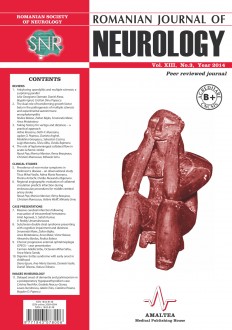SELECT ISSUE

Indexed

| |

|
|
|
| |
|
|
|

|
|
|
|
|
|
| |
|
|
HIGHLIGHTS
National Awards “Science and Research”
NEW! RJN has announced the annually National Award for "Science and Research" for the best scientific articles published throughout the year in the official journal.
Read the Recommendations for the Conduct, Reporting, Editing, and Publication of Scholarly work in Medical Journals.
The published medical research literature is a global public good. Medical journal editors have a social responsibility to promote global health by publishing, whenever possible, research that furthers health worldwide.
REGIONAL ANGIOGRAPHIC EVALUATION OF COLLATERAL CIRCULATION PREDICTS INFARCTION DURING ENDOVASCULAR PROCEDURES FOR MIDDLE CEREBRAL ARTERY STROKE
Raoul Pop, Monica Manisor, Remy Beaujeaux, Christian Marescaux, Valérie Wolff and Mihaela Simu
ABSTRACT
Backgroud and purpose. We aimed to improve patient selection by developing a regional angiographic evaluation of leptomeningeal collateral flow that can be used to predict infarction during stroke endovascular procedures.
Matherials and methods. We evaluated all consecutive patients treated for a middle cerebral artery occlusion between 2009 and 2013. Two readers performed a zonal collateral circulation evaluation in 5 cortical regions based on the vascular anatomy. Zonal scores were correlated with the presence of infarction in the same cortical sector on pretreatment and follow-up imaging.
Results. In 49 patients with 217 cortical zones we found good correlation between the degree of zonal collateral flow and the absence of infarction in the same zone on pretreatment imaging (receiver operator characteristic (ROC) curve of 0.74, p < 0.0001).
In a subgroup of 23 recanalized patients (TICI 3) with 105 cortical zones, retrograde collateral flow to the proximal M4 segment predicted the absence of infarction within the same zone on follow-up imaging (positive predictive value 89,4% , negative predictive value 80%). We found good inter-rater agreement for the presence of collateral flow to the M4 proximal segment or further – kappa 0.77 (p = 0.05, 95%CI 0.66-0.88).
The number of cortical regions with collateral flow to the M2 segment predicts the absence of insular infarction on follow-up imaging (ROC curve of 0,76, p = 0,001).
Conclusion. Anatomic collateral flow evaluation can provide a real-time estimation of the size and location of irreversible ischemia during stroke endovascular procedures.
Keywords: regional angiographic evaluation, leptomeningeal collateral flow, endovascular procedures, middle cerebral artery stroke
Full text | PDF
